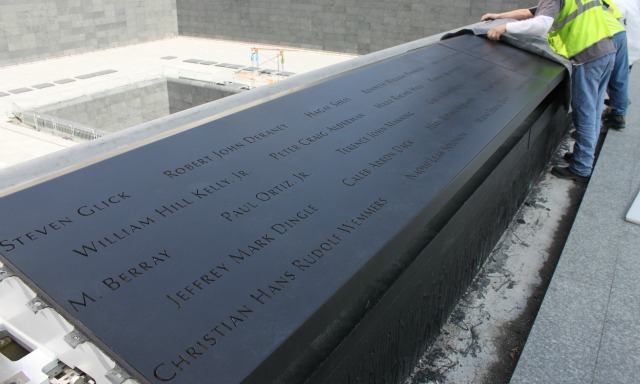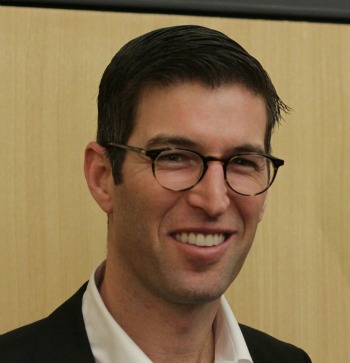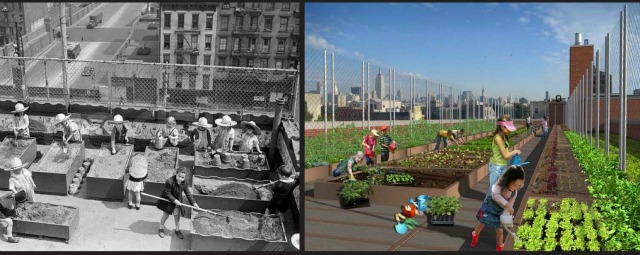The devoted dad last fall completed a “green roof” on his oldest child’s school building. In May, he was back in Israel to speak about his main area of expertise – urban architecture — at the
2013 Jerusalem International Tourism Summit. He also guest lectured at Hebrew University and met with a group of wounded Israeli veterans about a small proposed memorial in Israel “that could be very gratifying on a personal level,” he tells ISRAEL21c.
The son of Moshe Arad, Israel’s former ambassador to the United States, the 43-year-old architect clearly has come of age since his model for the memorial beat out 5,200 other entries in a 2004 international competition.
Between the time his design won and the time it was completed in September 2011, Arad received much press for his emotional struggle to shield his concept from myriad changes suggested by various stakeholders.
Today, he speaks of that period with calm equanimity; even gratitude.
“The tone of the memorial came through unchanged, and that’s a testament to the hard work of so many people,” he tells ISRAEL21c. “[New York] Mayor Bloomberg and his deputies shepherded the process through and gave us the opportunity to respond to challenges to the design process.”
 The bronze panel of names (Photo: ISRAEL21c)
The bronze panel of names (Photo: ISRAEL21c)
About seven million people have so far visited the memorial and surrounding park at the former World Trade Center site.
Pools in each footprint of the downed twin towers are fed by the largest manmade waterfalls in North America, and surrounded by bronze panels etched with the names of the 2,982 victims — including six from the 1993 attack on the towers, and 224 who died on planes hijacked on 9/11.
“It suggests commemoration and everyday life, a place that residents and workers in this neighborhood could utilize as much as visitors to the memorial,” says Arad. “I saw how public spaces allowed New Yorkers to come together after the attack in stoic defiance, leavened with a lot of compassion.”
He had watched from his Lower Manhattan roof as the south tower of the World Trade Center collapsed from the impact of the terror attack on September 11, 2001.
“Witnessing the attacks, and most importantly the way the city responded to them, was incredibly powerful and motivated me to start sketching ideas for a memorial,” Arad says. “I tried to express the idea of absence and loss, by having water cascade into empty spaces yet never fill them up.”
What makes cities great
Born in 1969, Arad spent his first three years in London, then one year in New York, three in Washington, four in Jerusalem, another year in New York and two more in Jerusalem, and then four years in Mexico City as his diplomatic family globe-trotted.
“I consider myself Israeli, but other things as well, and they’re not mutually exclusive,” he tells ISRAEL21c.
After a year at Dartmouth, he returned to Israel to serve from 1988 to 1991 in the Golani Brigade. “I never thought about not doing my military service,” he says. “I had grown up expecting to do it and wanting to do it.”
 Michael Arad (Photo courtesy of Wikimedia Commons)
Michael Arad (Photo courtesy of Wikimedia Commons) After his bachelor’s degree, he studied for his master’s at the Georgia Tech College of Architecture from 1995 to 1999. Living in New York ever since, he’s helped design two police stations, Union Station Tower, a 108-storey Hong Kong skyscraper and Espirito Santo Plaza, a 37-storey edifice in Miami that won the 2001 New York American Institute of Architects award.
Today he is a partner in Handel Architects and shares his Manhattan home with his wife, legal editor Melanie Arad Fitzpatrick, and children Nathaniel, 10; Ariel, seven; and Dani, two.
Arad helped plan and solicit funds for a “
green roof” on the top of Nathaniel’s public school building in the East Village. The
Fifth Street Farm, opened last September, allows pre-K through eighth-grade students to grow and eat fresh fruits and vegetables.
“I did not want to do a green roof only for its positive environmental impact but to see how we could weave this into the curriculum and health-and-wellness program at the school,” says Arad. “We wanted a real urban farm so kids could be engaged in agriculture activities and harvest and cook and eat their food onsite.”

The Fifth Street Farm project (Photo: ISRAEL21c)
Among the projects on his drawing board are a retail -housing-cultural complex on Manhattan’s Lower East Side and a hotel and residential tower for an Israeli developer in Long Island City.
“Our firm deals with density and diversity in urban sites,” explains Arad. “We see a vitality and significance to cities. What makes great cities great is the happenstance — not knowing what you’ll encounter around the next block.”
He says he is happy to see the renovation of older buildings in Tel Aviv, where his sister lives, and the addition of the light rail system in Jerusalem, where his parents reside. “It’s good to get people out of cars and onto the streets and public transportation. It creates an important sense of community.”
Source: ISRAEL21c